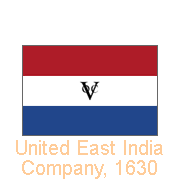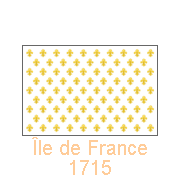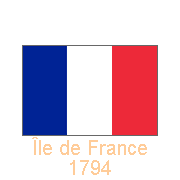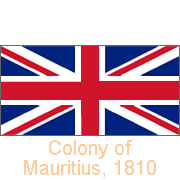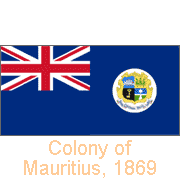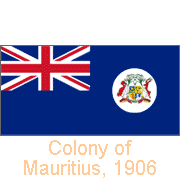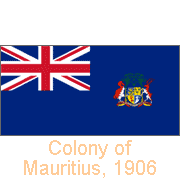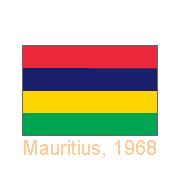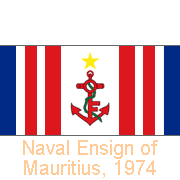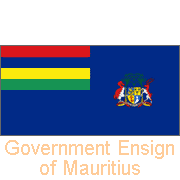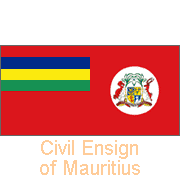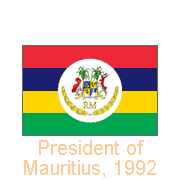Flags from Mauritius
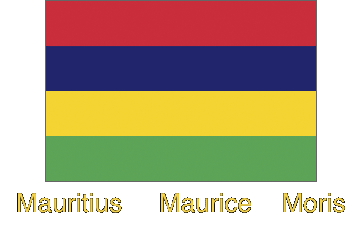
A Flag history of Mauritius
In 1598, a Dutch squadron under Admiral Wybrand van Warwyck landed at Grand Port and named the island Mauritius, in honour of Prince Maurits (Maurice) van Nassau, the stadholder of the Dutch Republic at the time. In 1638 the Dutch settled on the island. They were working for the “Vereenigde Oostindische Compagnie” (V.O.C.) - the United East India Company, an early megacorporation founded in 1602. A government-directed amalgamation of several rival Dutch trading companies, their house flag was the Dutch Tricolor with the Company emblem placed on the white stripe. The upper stripe of the flag of the V.O.C. was at first orange but changed to red just as the top stripe on the Dutch national flag did between 1630 and 1660.
you may then send it as a postcard if you wish.
The French took possession of Mauritius in 1715, renaming it Île de France and its main harbour Port-Louis, after their king Louis XV. The Royal standard was a plain white flag, with “fleur-de-lis”, the stylised lily, associated with the French monarchy. The French Revolution brought an end to the French monarchy and in 1790 a tricolour flag red-white-blue, derived from the cockades used during the French Revolution, was approved. The order was reversed to blue-white-red, the current design, by a resolution passed on 15 February 1794. This tricolour therefore also became the flag of Île de France.
In 1810 the French surrendered to the British and Mauritius became a British colony. The design of its flag, the Union Jack, dates from the Union of Great Britain and Ireland in 1801 and combines aspects of the three national flags. The red cross of Saint George (England) and the red saltire of Saint Patrick’s Flag (Ireland) are both superimposed on Saint Andrew’s Cross, the Flag of Scotland. In 1869 the Colonial flag of Mauritius was the Blue Ensign, with on a white disc, a shield placed on an ornate frame. The shield was divided into four quarters. It showed a three-masted sailing ship, symbolising colonisation and palm trees, representing the country’s tropical vegetation. A key and a six-pointed star shining down, reflecting in the sea, referred to the motto, in Latin, “Stella Clavisque Maris Indici” (Star and Key of the Indian Ocean), on the scroll below.
In 1906 a new coat of arms was designed by the Mayor of Johannesburg, Johann Van Der Puf and placed, in a white disc, on the Blue Ensign. The shield was now blue and gold with similar elements to the old one. It was supported by a dodo (the now extinct flightless bird) and the introduced sambar deer, both in red and silver, holding stalks of sugar cane. In 1923 the white disc was officially omitted. Mauritius became an independent nation on 12 March 1968, and a new flag, designed by primary school teacher Gurudutt Moher, was adopted. It has four horizontal bands of equal width: red, blue, yellow, and green. Red stands for the struggle for freedom and Independence; blue represents the Indian Ocean. Yellow represents the new light of Independence and green stands for the agriculture of Mauritius and its colour throughout the 12 months of the year. Mauritius became a republic 24 years later, on 12 March 1992.
In 1974 a separate Naval Ensign was designed for Mauritius. Its design has, on a white field, red, white, and blue vertical stripes and a central anchor/key emblem, with a yellow five-pointed star. It refers to the national motto, Star and Key of the Indian Ocean. There was also a blue Government or State Ensign and a red Civil Ensign, based on the British-style ensign flags with the National Flag in the canton. Mauritius became a republic on 12 March 1992, and a standard for the President was designed. The National Flag of Mauritius, with, on a white disc, the coat of arms of Mauritius over two curved golden laurel leaves and the letters “R.M.” (Republic of Mauritius) in gold.


